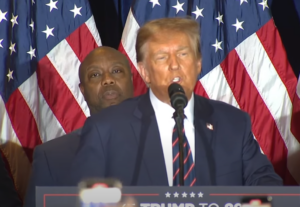 Just eight days after the 2024 GOP Presidential primary season began, it looks to be in its final throes.
Just eight days after the 2024 GOP Presidential primary season began, it looks to be in its final throes.
Former President Donald Trump put together a double-digit victory over former South Carolina Governor Nikki Haley, who desperately needed a win here in relatively hospitable New Hampshire.
Haley had the advantage of campaigning in the Granite State alongside popular Governor Chris Sununu, yet much like Iowa Gov. Kim Reynolds and her endorsement of Ron DeSantis, the support of the sitting Governor failed to make a discernible difference.
Of the 22 delegates at stake in this contest, Trump won 11 delegates and Haley took 8 delegates. Overall, the delegate count stands at: Trump 31 delegates, Haley 16 delegates, DeSantis 9 delegates, Ramaswamy 3 delegates.
Decision Desk HQ called the race for Donald Trump when all the polls closed at 8:00 pm EST. Among the other recent campaigns to secure an instant New Hampshire call are Mitt Romney in 2012, Bernie Sanders in 2016 as well as Donald Trump in 2016.
How do these results compare to the polls? Well, our final Decision Desk HQ/The Hill average of the New Hampshire Republican Primary polls put Trump at 50.8% and Haley with 36.9%.
Such results naturally lead to the question of what Haley will do now. She is not on the ballot for the February 8th Nevada Caucus and the next statewide contest isn’t until the South Carolina primary on February 24th. Early polling, however, suggests that Haley risks losing to Trump in her home state if she continues to compete there.
As a result, this may be the final competitive contest of this Presidential primary season. If that is indeed the case, then we’re looking at the longest general election campaign ever.
From the mid-19th Century through the infamous 1968 Democratic National Convention, Presidential nominations were always decided in the summer. After the adoption of a primary system, the earliest that the Democratic and Republican Parties settled on their nominees was March 3rd, 2004.
Democratic Primary Results
Technically, nothing was decided in New Hampshire’s Democratic contest.
After all, the DNC stripped the Granite State of its 23 delegates when it refused to follow the new DNC calendar. That timetable, assembled by the Biden White House, was crafted to give South Carolina the first primary.
The Palmetto State, you may remember, resurrected Biden’s 2020 campaign after his fifth place finish in New Hampshire and a fourth place showing in Iowa.
As you might expect, New Hampshire Democrats weren’t exactly thrilled with this development, so Minnesota Congressman Dean Philips sought to take advantage by contesting this beauty contest and embarrassing President Biden.
To combat Philips’s effort, the Biden campaign subsequently launched their own write-in effort.
Philips was aiming to re-create the scenario which occurred in the 1952 and 1968 Democratic New Hampshire primaries, where poor performances by respective incumbent Presidents Harry Truman and Lyndon Johnson led them to drop out of the race.
In those contests, challengers Sen. Estes Kefauver and Sen. Eugene McCarthy secured 54.6% and 41.9% respectively, far higher than what Rep. Phillips was able to earn last night.
Now focus will turn to the first Democratic contest where delegates are actually up for grabs, which will take place in South Carolina on Saturday February 3rd.
Turnout and Interest in the 2024 Election
With the 2024 primaries possibly over, it’s a good time to take a look at the level of interest in this contest, which so far seems to be lacking. In fact, the Biden team believes that this phenomenon is key to Trump’s rise in the polls. They’ve made the case that many undecided voters in their studies simply don’t believe Trump will actually be the 2024 GOP nominee.
Perhaps voters are still incredulous because they weren’t really paying attention up to now.
After all, last week’s Iowa Caucus coverage drew only 4.67 million viewers across CNN (688K), Fox News (2.83M) and MSNBC (1.15M), the lowest total audience since 2004. Of course, last week’s viewership likely suffered from going head-to-head with the Eagles-Bucs NFL Wild Card game, which drew 28.6 million people, as well as the Emmy Awards, which scored a record low 4.3 million viewers. Let’s compare 2024’s Iowa Caucus cable news viewership to all the other elections so far this century:
2020: 8.5 million
2016: 10.2 million
2012: 5.13 million
2008: 6 million
2004: 3.4 million
2000: 1.5 million
Finally, there’s the actual voter turnout numbers. Last week in Iowa – which tends to lag far behind New Hampshire – the total turnout was just 110,272, the weakest total since way back in 2000.
Tonight, voter turnout stands so far at 296,861 in the Republican New Hampshire primary and 102,587 in the Democratic New Hampshire primary. See for yourself how that compares to New Hampshire contests since 2000:
2020 Dem: 298,377
2020 GOP: 153,674
2016 Dem: 253,062
2016 GOP: 285,916
2012 Dem: 60,659
2012 GOP: 248,475
2008 Dem: 287,527
2008 GOP: 234,851
2004 Dem: 219,787
2004 GOP: 67,833
2000 Dem: 154,639
2000 GOP: 237,640
I’ll address these final turnout totals next week – as part of my larger preview of the Democratic South Carolina Primary and the rest of the primary contests coming up in February – so stay tuned!